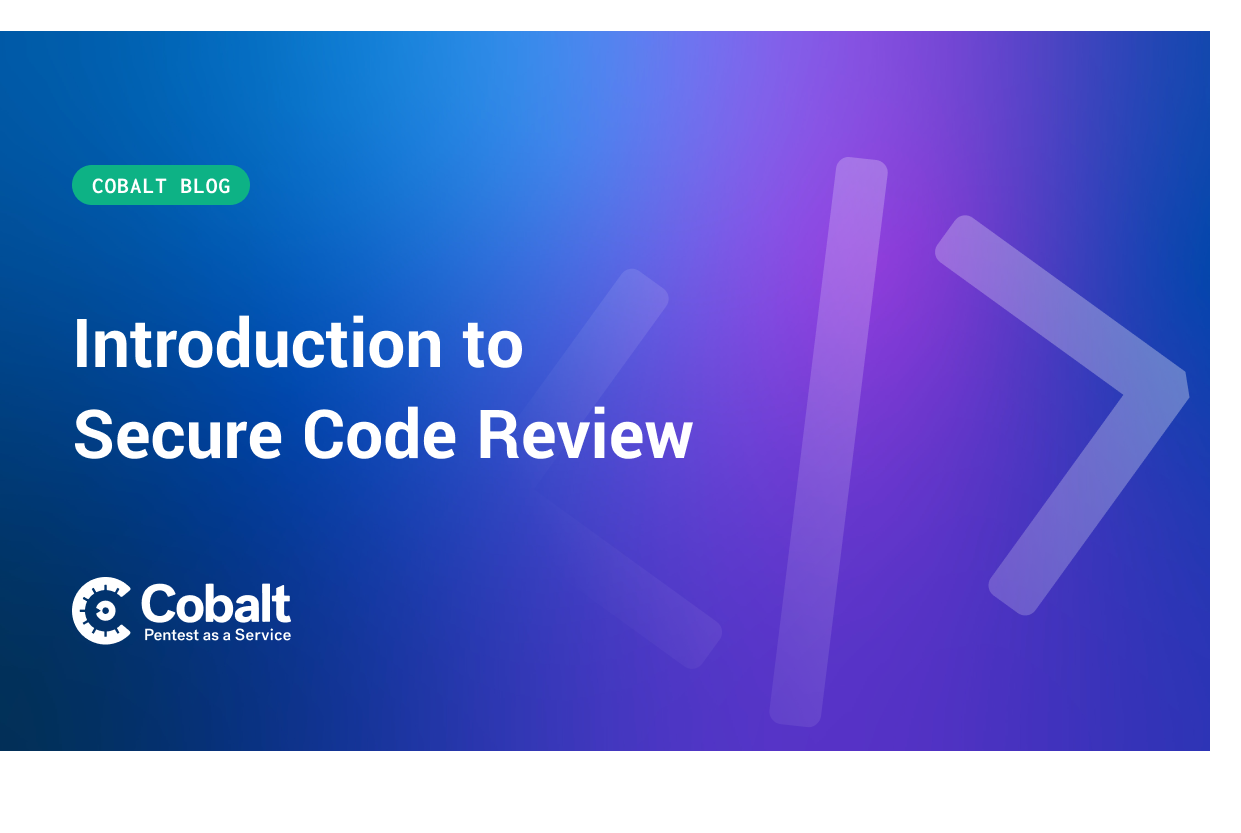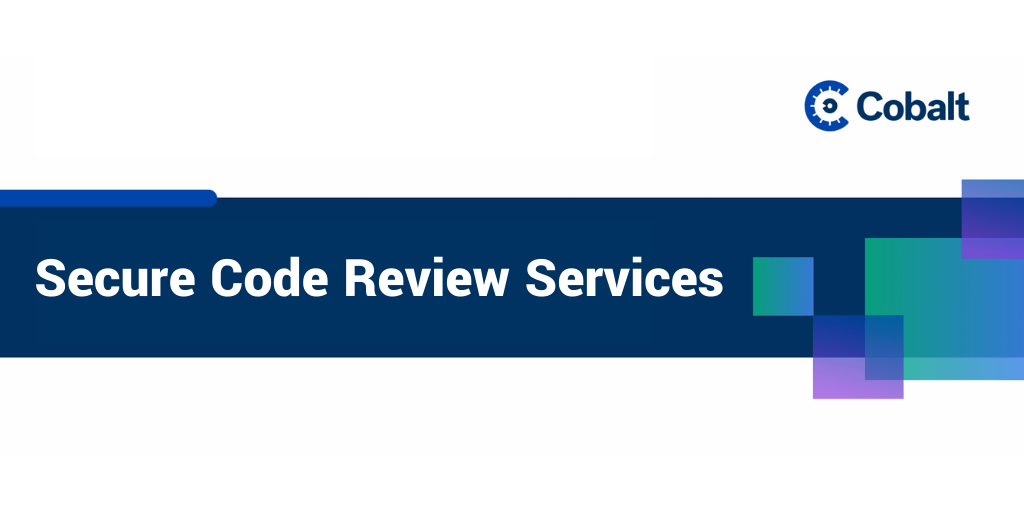Code is the backbone of modern software applications. Understanding the importance of secure code development is paramount.
To shed light on this critical aspect of software engineering, a Cobalt Core Lead Pentester shared steps to take in Secure Code Review in our latest Cobalt Core Training.
Here we’ll share key takeaways from the training, providing you with an intro to secure code review.
The Role of Code Review in Secure Development
Code review is a critical component of the software development lifecycle. It serves as a crucial checkpoint to identify and rectify security vulnerabilities, ensuring that software remains resilient to potential threats throughout its lifespan.
To start, it’s important to understand the difference between Code Review and Secure Code Review.
Code Review
- Purpose: The primary goal of a code review is to improve the overall quality of the codebase, enhance maintainability, and ensure that the code aligns with the project's coding standards and best practices.
- Focus: A standard code review evaluates aspects like code readability, consistency, maintainability, code style adherence, adherence to design patterns, and the correctness of the code in terms of the specified requirements.
- Participants: Code reviews typically involve developers and QA team. They are responsible for ensuring that the code is of high quality and that it meets the project's goals.
Secure Code Review
- Purpose: The primary goal of a secure code review is to identify and mitigate security vulnerabilities in the codebase, reducing the risk of potential security breaches and vulnerabilities being exploited.
- Focus: A secure code review specifically looks for security-related issues, such as input validation problems, authentication and authorization flaws, data leakage, hardcoded data, SQL injection, Cross-Site Scripting (XSS), and other vulnerabilities that could be exploited by attackers.
- Participants: Secure code reviews often involve security experts or specialized security teams in addition to developers. These experts have a deep understanding of security principles and threats and can identify potential security issues that might be missed in a standard code review.
Goals of Secure Code Review
- Harden the code, making it more secure.
- Fail fast and before releasing the code.
- Find specific security-related defects before malicious actors can exploit them and compromise the CIA triad.
- Reduce attack vectors at runtime.

Effective Secure Code Review Methodology
There are four stages of a successful Secure Code Review Process. A structured approach is crucial for success.
Planning
This begins with clear objective setting, where the goals and purpose of the review are defined.
Scope determination follows, establishing the boundaries of what will be examined during the review process. Equally important is the assignment of reviewers with the appropriate expertise and knowledge.
Next, setting a timeline for the review ensures that it progresses efficiently and aligns with the overall project. Finally, effective communication throughout the process, including feedback and discussions, is key to resolving issues and fostering collaboration among the review team to generate the best results.
Code Review Preparation & Execution
Conducting a security code review begins with a deep understanding of the application's features and business rules. This contextual awareness provides the necessary insight into how the code functions within its specific environment.
Additionally, thorough documentation aids in identifying potential vulnerabilities. Examples include architectural diagrams and data flow charts,
Next, establishing the appropriate development and testing environments is essential for replicating real-world scenarios during the review. This will ensure testing does not disrupt any code already in production.
Finally, having a well-structured security code review checklist ensures that critical areas, such as authentication mechanisms, data validation, and encryption practices, are systematically examined to bolster the application's resilience against potential threats.
Equally important is the meticulous setup of development and testing environments to replicate real-world scenarios accurately. To ensure a thorough examination, a well-structured security code review checklist serves as a guide, ensuring critical aspects like authentication, data validation, and encryption are scrutinized to fortify the application against potential threats.
Reporting
Calculating risk levels based on a standardized framework aids in prioritizing and addressing vulnerabilities appropriately.
Equally important is the presentation of clear and detailed evidence, offering a transparent view of the identified vulnerabilities and their potential impact. To facilitate remediation, a detailed Proof of Concept (POC) becomes invaluable, providing a step-by-step demonstration of how the vulnerabilities can be exploited, enabling developers and security teams to understand the threat and implement precise fixes.
These elements together form the cornerstone of a robust vulnerability management strategy.
Identifying Common Security Vulnerabilities
For a comprehensive Secure Code Review you should use a combination of automated tools and manual review. Below we explain the best ways to use both tactics.
Automated Tools for Secure Code Review
- Identify hardcoded secrets: user and passwords, private certificates, encryption keys, API Keys.
- Discovery Tools to help you find: buffer overflows, cross-site scripting (XSS), SQL injections, XXE, path-traversal and command injection issues.
- SCA Tools: to analyze third-party and open-source components to detect publicly disclosed vulnerabilities (CVE) contained within a project’s dependencies
- Identify missing configurations: in containers, docker images, K8 clusters, or other configuration files.
Manual Review
- Complex Logic and Context: For code with complex logic or where understanding the context is crucial, manual review is essential. Humans can interpret the big picture and evaluate how code fits into the project's goals.
- Uncommon or Zero-Day Vulnerabilities: Manual reviewers can often detect new or zero-day vulnerabilities that SAST tools might miss. They can apply creativity and experience to uncover less common issues.
- Follow Data Flow: Identify from code where the vulnerability exists and from the app where it can be exploited
- Use a code review checklist: Ensures coverage of common security vulnerabilities.
Integrating SAST Tools into Secure Code Reviews
Static Application Security Testing (SAST) tools are invaluable in automating the detection of vulnerabilities within source code. It’s important to select the right SAST tools for your specific needs and integrate them seamlessly into the development pipeline. This integration not only helps catch issues early but also accelerates the development process while maintaining code security.
Secure Code Review with Cobalt
Understanding the role of code review in secure development is crucial for protecting software applications against ever-evolving threats.
Effective code review methodology, the identification of common security vulnerabilities, integration of SAST tools, and the utilization of the proper tools are all vital aspects of ensuring code security. By implementing these practices, development teams can enhance the security of their applications, protect sensitive data, and build trust among users.
As the cybersecurity landscape continues to evolve, staying informed about the latest practices and tools for secure code development remains essential.
If you’re interested in running a Secure Code Review engagement with Cobalt, visit Cybersecurity Services for more information.



















